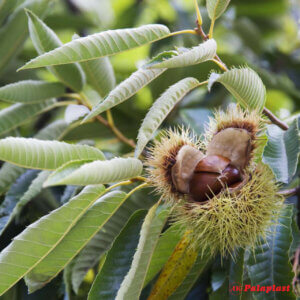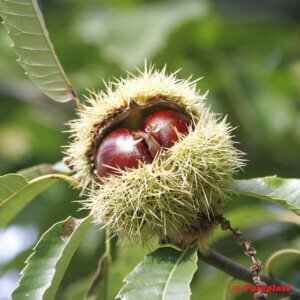CHESTNUT
- The chestnut tree belongs to the Fagaceae family, genus Castanea, with the main species being the European chestnut (Castanea sativa), the American chestnut (Castanea dentata), the Japanese chestnut (Castanea crenata) and the Chinese chestnut (Castanea mollissima).
- Chestnut is a large tree that can grow to a height of up to 35 meters. There are finds dating back to the Bronze Age, while during the Middle Ages it was the food of the poor thanks to the high nutritional value of its nut.
- Chestnut trees are native or cultivated in orchards for their excellent quality nut, which is a typical autumn and winter delicacy, but also for their robust timber or as ornamental trees in parks.
- Chestnut tree flourishes in a slightly cold climate with an average temperature of 8 – 15⁰C, while although during the dormancy period it can withstand temperatures as low as -17⁰C it is extremely sensitive to spring frosts as this is the period of flower development. For this reason chestnut trees grow best on sloping sites where frosts do not occur very easily due to the movement of cold currents.
- Soils appropriate for the growth of chestnut trees are deep, sandy or sandy loam, well drained, otherwise its deep roots will be at risk of suffocation. The pH of the soil should ideally be between 5,5 and 6,5, while it is characteristic of chestnut trees that they are extremely sensitive to high calcium content in the soil (pH > 6,5), which makes it virtually impossible to grow chestnuts in this type of soil.
- The seed, the edible part of chestnut, grows in a spiny covering that protects it while immature and opens wide when the seed is ripe and ready to harvest. This spiny covering, called a burr, surrounds one to three nuts, depending on the variety. Chestnuts are rich in nutrients (starch, sugars, proteins, fats and fiber), minerals and vitamins B1, B2, B3, B5, C, and are a food with a fairly high caloric value without cholesterol. Fresh chestnuts contain 50% water, 45% carbohydrates and 5% vegetable oil, high fiber content and unlike other nuts contain fats at a very low level (only 2-5%).
- Worldwide, the annual production of chestnuts reaches 2.5 million tons, with China (1st – 1.8 million tons) accounting for almost 75% of it. Spain and Bolivia follow with a significant difference, while Greece ranks 8th in world production.
IRRIGATION OF CHESTNUT TREES
- Chestnut is a water demanding crop, requiring an annual rainfall of at least 700mm. Young trees need frequent watering to develop a robust root system. But also during the fruiting and growth stage (July – September) irrigation is essential to allow the chestnuts to grow in size and flesh. Moreover, the use of a drip irrigation system reduces the leaching of nutrients from the soil and achieves targeted irrigation towards the root system of the trees.


Palaplast has a wide range of products that can be used to install a reliable and efficient drip irrigation system for chestnut trees:
- Irrigation pipes AGROPAL HDPE 80 και LDPE
- Pressure Compensating Driplines, Driplines (Paladrip – Palaplast, Paladrip-XL – Palaplast, Paladrip-Slim – Palaplast)
- Dripline fittings
- Drippers (Self Compensating Drippers – Adjustable Drippers – On Line Drippers)
- Filters



